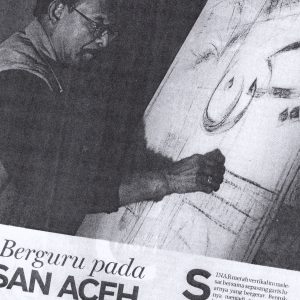
Carla Bianpoen: Contributor / Jakarta
At 80 years, Pirous, an artist considered a pioneer of Islamic painting in Indonesia, is as energetic and fit as ever before: Speaking at Selasar Sunaryo, Bandung, to hundreds of guests who had come for his 80th birthday celebration on March 11, he vividly recalled the moment of his epiphany.
It was at the Met (Metropolitan Museum of Art), he revealed. He was studying in America (1969-70) visiting as many museums and art venues as possible. Then, at the Met in New York, he was struck by the beauty of calligraphy in works from the Middle East. It took him back to his childhood in Meulaboh, Aceh, where Arabic calligraphy abounded. There and then, he knew he had found his identity, and his destiny. From then on Pirous’s art focus was on Arabic calligraphy.
Kenneth M. George, professor of anthropology at UW-Madison, the US, who wrote extensively on Pirous, says that A.D Pirous (short for Abdul Djalil Pirous) is a pioneer in melding Western abstraction with traditional Islamic forms and themes, notably Koranic calligraphy, which portrays Koranic verses. “When he began to combine abstraction and Koranic calligraphy in the 1970s, his influence quickly spread. He awakened fellow Muslims to contemporary painting, and helped them think of themselves as an art producing community.” Nevertheless, no significant breakthrough in Islamic painting has been recorded after Pirous and exhibitions have been scarce, although Pirous helped organize festivals of Islamic art.
The exhibition “Ja’u Timu” (Mengarahlah ke Timur or Head East), an exhibition of works from his personal collection, which is held to mark his 80th birthday as Selasar Sunaryo, Bandung (until 8 April), is therefore a rare opportunity to see, explore and feel the spirit of Islamic art, a term that is for many people as unclear and debatable as the term Contemporary Art. As evident in the show, not all works are calligraphic or have koranic texts, but there is a sense of the spiritual that can’t be missed. Among Pirous most recent works; are the mixed media painting on which broken ceramic pieces of the early centuries caught up by the Tsunami are “glued” as stirring marks of Nature’s wrath.
The title of the show refers to the advice that 14 years old Pirous received from his dying father, to go East. As he did go East literally, when he was young, in later years the advice came to have a more philosophic content linked to light, the source of light and enlightenment. But in a more realistic context, Pirous urges artists to delve into the treasures and the norms of the East instead of looking to the West. “Maybe one has to know the West first before being able to understand the East. Or one may first appreciate the Eastern reality and find the West within.” Pirous art has now reached its pinnacle. Pirous says what matters in his art works now is more “what to say, rather than how to say [it]”.
Pirous was born in Meulaboh, a town on the west coast of Aceh, the northern-most province/state on the island of Sumatra. He was the fifth of six children in a relatively well-to do family. He went to school in Meulaboh’s elite, Dutchrun elementary school while also receiving the Koran and writing Arabic. In 1950, at the age of 18, Pirous left Aceh for the North Sumatran city of Medan to continue his studies at that city’s first rate middle school and high schools.
He did well in school and art was what he did best. His middle school art teacher urged him to consider art school. But it was the exhibition of modernist painters like Zaini, Handrio, Nashar, Widayat and Sudjojono who came from Jakarta and Yogyakarta that spurred his desire to pursue art education. Pirous applied to the academies in Bandung and Yogyakarta, and went to Bandung because acceptance to the Bandung Institute of Technology (ITB) arrived first. As he developed his skills, Pirous did not stick to canvas only, but was also active as a teacher at his almamater. His colleagues and ex students think of him as a leader in the development of art, particularly of Islamic art in Indonesia. He is also considered an academic scientist in visual art. For almost 40 years (1964-2002), Pirous was a lecturer at visual art and design of graphic design study program which has recently become the visual communication design study program.
It is said that behind every successful man there is a woman. This rings very true for Pirous, whose wife is Erna Garnasih, a graduate of the ITB and a painter in her own right..

PAMERAN ARSIP ARTIKEL #1


Jl. Bukit Pakar Timur II/111
Bandung, 40198
Indonesia.
Hours
Tuesday – Sunday:
10:00AM – 5:00PM
+62 22 2530966
(office hour only)